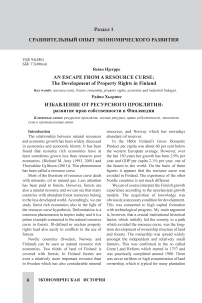An escape from a resource curse: the development of property rights in Finland
Автор: Hjerppe Reino
Журнал: Экономическая история @jurnal-econom-hist
Рубрика: Сравнительный опыт экономического развития
Статья в выпуске: 1 (16), 2012 года.
Бесплатный доступ
This paper explores the question how Finland was able to escape the resource curse. The resource in this case is forests. We argue that the basic reason for the resource curse in forests lies in the ill-de? ned or narrow property rights. In the case of narrow ownership of the resource, bene? ts ? ow only to a narrow circle of people - an enclave. This enclave may consist of domestic or foreign owners, private persons or companies. On the other hand common or ill-de? ned ownership rights usually lead to problems of commons, like deforestation or resource depletion. These are aggravated by institutional weaknesses, like weak state regulation or corruption. According to the Finnish experience, wide ownership of the resource spreads incomes from the resource in the society. Bene? ts ? ow to a larger segment in the society, strengthening the total demand and creating favourable conditions for economic growth. Wide ownership also creates better chances for democratic and non-corrupt decision making. It is also important that the economy has the ability to develop backward and forward economic linkages to the resource industry. State policy can also help, for example, by using a resource tax or collecting royalty payments and using these revenues for purposes which bene? t the whole society. In this paper I concentrate especially to the question how the property rights of the resource have been developed in Finland. Formation of property rights has taken a long time. In fact, they can be seen as a result of a process lasting centuries. A major question in this context is how a small-scale private ownership of forests has developed in Finland instead of plantation, common or state ownership. In different parts of the world there are major differences in forest ownership and there are obviously different historical reasons behind this.
Resource curse, economic and industrial linkages, forests ownership, property rights
Короткий адрес: https://sciup.org/14723617
IDR: 14723617
Список литературы An escape from a resource curse: the development of property rights in Finland
- Auty, Richard M. (1993). Sustaining Development in Mineral Economies: The Resource Curse Thesis. Routledge, London.
- Auty, R.M. (ed) (2001). Resource Abundance and Economic Development,, Oxford University Press.WIDER Studies in Development Economics http://ukcatalogue.oup.com/category/academic/series/economics/wider.do>
- Baldwin, R (1956). Patterns of Development in Newly Settled Regions. Manchester School of Economic and Social Studies 24, 161-179
- Corden WM, Neary JP (1982). "Booming Sector and De-industrialisation in a Small Open Economy http://en.wikipedia.org/wiki/Small_open_economy>". The Economic Journal 92 (December): 825-848
- Corden, Max (1984), Booming Sector and Dutch Disease Economics: A Survey, Oxford Economic Papers 36(3), November 1984, pp. 359-80.
- Fellman, Susanna (2000). Uppkomsten av en direktorsprofession. Industriledarnas utbildining och karriar i Finland 1900-1975 (The emergence of a managerial profession: the educational and career background of industrial managers in Finland, 1900-1975). Finska Vetenskaps-Societeten, Helsingfors.
- Fukuyama, Francis (1995). Trust: The Social Virtues and the Creation of Prosperity. Free Press, New York.
- Granovetter, Mark S. (1973) The Strength of Weak Ties. American Journal of Sociology 78 (1973): pp.1360-1380.
- Gylfason, Thorvaldur (2001). Natural Resources, Education and Economic Development. European Economic Review (Elsevier) 45 (4-6): 847-859
- Hirschman, Albert O. (1958) The Strategy of Economic Development. Yale University Press, New Haven.
- Hjerppe, Riitta (1996). Finlands historical national accounts 1860-1994: calculation methods and statistical tables. Jyvaskylan yliopisto, Suomen historian julkaisuja 24, Jyvaskyla
- Hjerppe Riitta and Hjerppe Reino (2010). An Escape from a Reource Curse -the Case of Finland. ERSA/FRESH Conference, 24-26 November, STIAS, Stellenbosch, South Africa.
- Hjerppe, Riitta (1989). Finnish economy 1860-1985. Growth and Structural Change, Studies in Finlands Economic Growth XIII, Bank of Finland Publications, Helsinki
- Huurre, Matti (2003). Viljanviljelyn varhaisvaiheet (Early Stages of Agriculture), in Suomen maatalouden historia (The History of Finnsih Agriculture), SKS, Helsinki.
- Jutikkala, Eino (1958). Suomen talonpojan historia (The history of the Finnish peasant). Suomen kirjallisuuden seura. Helsinki.
- Maddison, Angus (1991). Dynamic Forces in Capitalist Development. A Long-Run Comparative View. Oxford University Press, Oxford.
- North, Douglass C. and Thomas, Robert Paul (1973). The Rise of the Western World. A New Economic History. Cambridge University Press.
- North DC (1990). Institutions, institutional change and economic performance. Cambridge University Press.
- Palo, Matti and Lehto, Erkki (2012). Private or Socialistic Forestry? Forest transition in Finland vs. Deforestation in the Tropics. Sringer.
- Rasila Viljo, Jutikkala Eino and Makela-Alitalo Anneli (2003). Suomen maatalouden historia (History of the Finnish agriculture). Suomalisen kirjallisuuden seura (SKS). Helsinki.
- Sachs, Jeffrey D; Warner, Andrew M (1995) Natural resource abundance and economic growth. NBER Working paper 5398.
- Senghaas, Dieter (1985). The European Experience. A Historical Critique of Development Theory.Berg Publishers, New Hampshire.
- Westoby, JC (1962). Forest Industries in the Attack on Economic Underdevelopment, Unasylva 16(4):168-201. FAO, Rome.


